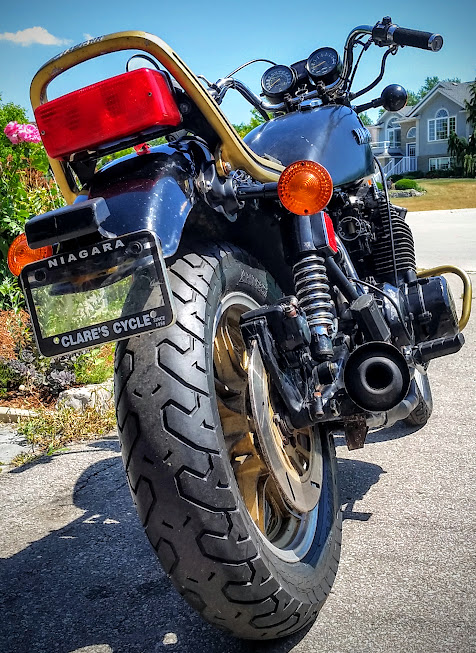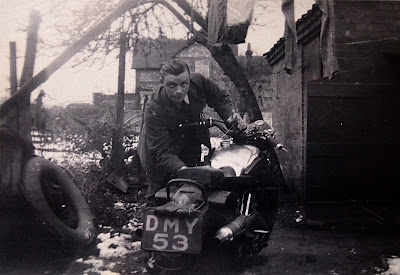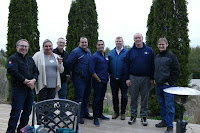 I sold the Yamaha XS1100 yesterday. With the Concours on life support I haven’t had the wrenching time to work on the Yam, so I put it up for sale to make room in an otherwise overcrowded garage full of old Japanese bikes that aren’t running.
I sold the Yamaha XS1100 yesterday. With the Concours on life support I haven’t had the wrenching time to work on the Yam, so I put it up for sale to make room in an otherwise overcrowded garage full of old Japanese bikes that aren’t running.
The Mid-Night Edition Yamaha came to me in rough shape both physically and legally. With only a hand written note I had to figure out how to get continuity of ownership restored. It was a relatively simple process, but you need to be lucky (I was) and figure out how to get an affidavit worked out (I did).
Where I got lucky was that the Yamaha didn’t have a brand on it. Had it been a write off at any point previously (and it had a long and storied eleven page history – so it was entirely possible), I’d have been up a creek. That legal ownership near miss got me thinking about more complex ownership issues, especially when I saw this Versys pop up on Kijiji with a sad history:

A bit of research has shown that this bike’s ‘irreparable Ontario title’ means it’ll never ride on the road again, it can only be used for parts. For a bike that appears to have relatively minor damage, this seems a shame. Others have had frustrating experiences with insurance companies writing off bikes rather than letting them buy them back and repair them (people get emotionally attached to bikes). It’s a matter of mathematics for the insurance company though. A bike may be repairable, but the cost of those repairs outweigh the value of the bike, so it’s deemed irreparable.

So what would you do with this otherwise lovely Versys? You would need to pick up another Versys frame with a working title (no damage, no history of crashes) and then graft the better parts from this Versys (not the front wheel) to that valid frame. You’d have a low mileage bike with relatively new parts, but it would cost you two bikes and a lot of time and talent to make it happen. I’ve never seen even an older Versys for sale for any less than twenty-five hundred bucks, so you’re looking at $5000 plus a lot of work to have a modern, road-worthy Versys 650.
If you had a high mileage, older Versys sitting in the garage, it might make sense, but things change over time (especially mounting brackets and other niggly bits), so you might find that your expensive donor parts don’t actually fit. No matter how you frame it (!), it’s more trouble than it’s worth.
 If this were a limited edition or classic bike, it might make a good parts bike, but a relatively anonymous, recent Japanese bike? You can buy an immaculate, year older bike with half the kilometres and no crashes for less than five grand.
If this were a limited edition or classic bike, it might make a good parts bike, but a relatively anonymous, recent Japanese bike? You can buy an immaculate, year older bike with half the kilometres and no crashes for less than five grand.
The moral of all this? I’ve found two. Firstly, you’re taking a big risk buying a bike without the ownership on hand. I got lucky with the Yamaha, but I could have as easily gone in and found that it was scraped and what I’d bought could never legally ride on the road again. Secondly, if you see a bike with anything other than a working title in Ontario, stay away unless you’re looking for a parts bike, in which case price it accordingly.
Links & Information on Motorcycle Branding in Ontario
(and generally in North America)
https://www.ontario.ca/laws/regulation/020376/v1
https://en.wikipedia.org/wiki/Vehicle_title_branding
http://www.mto.gov.on.ca/english/vehicles/vehicle-branding-program.shtml
http://www.mto.gov.on.ca/english/vehicles/vehicle-branding-program-faq.shtml
http://www.gtamotorcycle.com/vbforum/archive/index.php/t-141734.html?s=73a91a4860714e30a183b20b315ff3d5
“In Ontario there is no “rebuilt” for motorcycles. They are either clear title, or scrap. If it’s ever been ‘branded’, then it can never be licensed for the road. You need to have a clean, unbranded frame in order to license a motorcycle for on-road use.”
http://ontariorodders.activeboard.com/t52382265/salvage-title/
http://www.kijiji.ca/b-motorcycle-parts-accessories/gta-greater-toronto-area/frames-with-titles/k0c309l1700272
http://www.gtamotorcycle.com/vbforum/archive/index.php/t-177188.html
http://www.gtamotorcycle.com/archives/archive/index.php/t-54857.html
http://www.gtamotorcycle.com/archives/archive/index.php/t-131215.html
Q9: Can I legally drive an “Irreparable” or “Salvage” vehicle on Ontario roads?
No. Vehicles branded as “Irreparable” can never be driven on Ontario roads. They can only be used for parts or scrap.
Vehicles branded as “Salvage” can’t be driven on the road, but they can be towed for the purposes of repair or receiving a Safety Standards Certificate. If you want to drive a “Salvage” vehicle, it must be upgraded to “Rebuilt.” This can only be done if it has passed a structural inspection and safety inspection to be registered for on-road use.
Q10: How can I change the brand on my vehicle from “Salvage” to “Rebuilt”?
To make sure your vehicle meets minimum safety standards, it must pass an inspection and be issued a Structural Inspection Certificate (SIC). You must submit the SIC and registration permit to a Ministry of Transportation licensing office. Once accepted and approved, the “Salvage” brand will be changed to “Rebuilt.”
Once the “Rebuilt” brand is placed on the vehicle registration file, you must obtain a Safety Standards Certificate from any Motor Vehicle Inspection Station so the vehicle can be declared “fit.” The vehicle may then be plated and legally operated (once it has been provided with a Drive Clean certificate, if required).
 Since seeing pictures of my granddad on a motorbike I’ve been curious about my family history with bikes. Knowing that bikes have been in my family for generations is kinda cool. When home in August I got to see some more bike-related family history. My Uncle had a couple of albums I hadn’t seen before that had some fantastic pictures in them. It’s always nice to see pictures of Granddad, and seeing him working on his bike was wonderful. I guess if you rode a bike in the 1940s and 50s you spent some time making sure it was running right, or it wasn’t running at all.
Since seeing pictures of my granddad on a motorbike I’ve been curious about my family history with bikes. Knowing that bikes have been in my family for generations is kinda cool. When home in August I got to see some more bike-related family history. My Uncle had a couple of albums I hadn’t seen before that had some fantastic pictures in them. It’s always nice to see pictures of Granddad, and seeing him working on his bike was wonderful. I guess if you rode a bike in the 1940s and 50s you spent some time making sure it was running right, or it wasn’t running at all.



















































